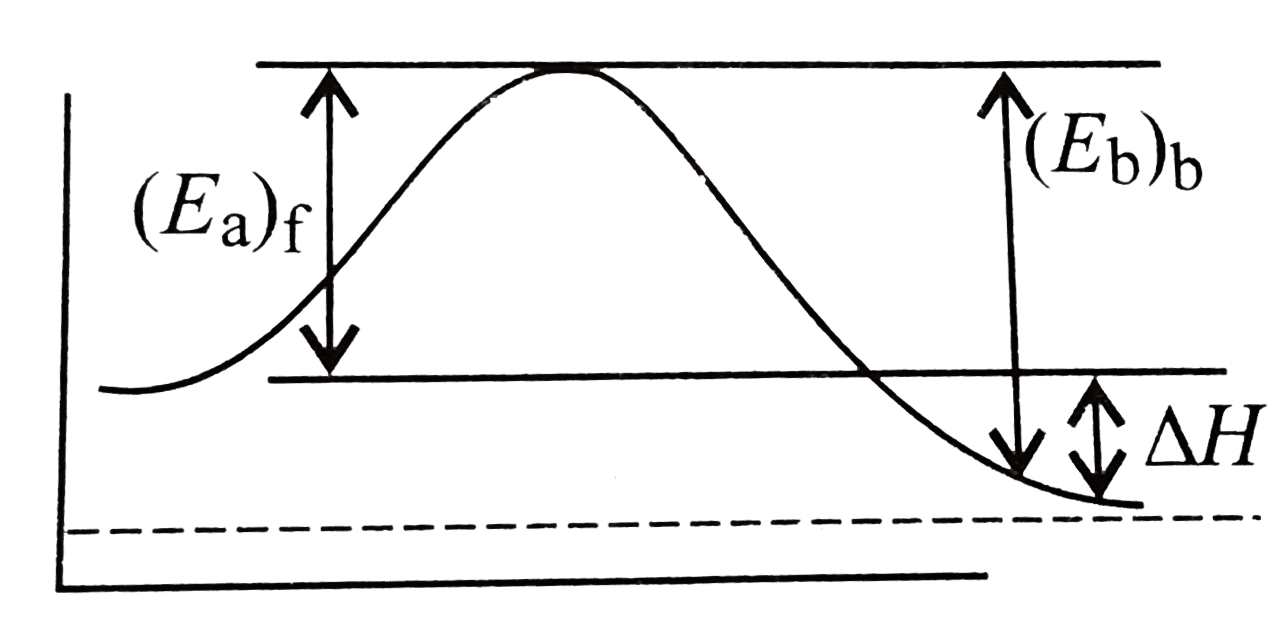In a hypothetical reaction X→Y, the activation energy for the forward backward reactions are 15 and 9 kJ mol−1 respectively. The potential energy of X is 10 kJ mol−1. Which of the following statement is/are correct?
(i) The threshold energy of the reaction is 25 kJ mol−1
(ii) The potential energy of Y is 16 kJ mol−1
(iii) Heat of reaction is 6 kJ mol−1
The reaction is endothermic.
Only (i)
Only (i) and (ii)
Only (ii) and (iii)
All are correct
The correct Answer is:D
To solve the problem, we need to analyze the given data and calculate the required values step by step.
Step 1: Understanding Activation Energy
The activation energy for the forward reaction (Ea_f) is given as 15 kJ/mol, and for the backward reaction (Ea_b), it is 9 kJ/mol.
Step 2: Calculate the Heat of Reaction (ΔH)
The heat of reaction (ΔH) can be calculated using the formula:
ΔH=Efa−Eba
Substituting the values:
ΔH=15kJ/mol−9kJ/mol=6kJ/mol
Step 3: Determine the Potential Energy of Y
The potential energy of Y can be calculated using the potential energy of X and the heat of reaction:
Potential energy of Y=Potential energy of X+ΔH
Given that the potential energy of X is 10 kJ/mol:
Potential energy of Y=10kJ/mol+6kJ/mol=16kJ/mol
Step 4: Calculate the Threshold Energy
The threshold energy (which is the energy required to start the reaction) is the potential energy of X plus the activation energy for the forward reaction:
Threshold energy=Potential energy of X+Efa
Substituting the values:
Threshold energy=10kJ/mol+15kJ/mol=25kJ/mol
Step 5: Determine if the Reaction is Endothermic
Since the heat of reaction (ΔH) is positive (6 kJ/mol), the reaction is endothermic.
Summary of Results
- (i) The threshold energy of the reaction is 25 kJ/mol. (Correct)
- (ii) The potential energy of Y is 16 kJ/mol. (Correct)
- (iii) The heat of reaction is 6 kJ/mol. (Correct)
- The reaction is endothermic. (Correct)
Final Conclusion
All statements are correct.
---
The activation energy for the forward reaction (Ea_f) is given as 15 kJ/mol, and for the backward reaction (Ea_b), it is 9 kJ/mol.
The heat of reaction (ΔH) can be calculated using the formula:
ΔH=Efa−Eba
Substituting the values:
ΔH=15kJ/mol−9kJ/mol=6kJ/mol
The potential energy of Y can be calculated using the potential energy of X and the heat of reaction:
Potential energy of Y=Potential energy of X+ΔH
Given that the potential energy of X is 10 kJ/mol:
Potential energy of Y=10kJ/mol+6kJ/mol=16kJ/mol
The threshold energy (which is the energy required to start the reaction) is the potential energy of X plus the activation energy for the forward reaction:
Threshold energy=Potential energy of X+Efa
Substituting the values:
Threshold energy=10kJ/mol+15kJ/mol=25kJ/mol
Since the heat of reaction (ΔH) is positive (6 kJ/mol), the reaction is endothermic.
- (i) The threshold energy of the reaction is 25 kJ/mol. (Correct)
- (ii) The potential energy of Y is 16 kJ/mol. (Correct)
- (iii) The heat of reaction is 6 kJ/mol. (Correct)
- The reaction is endothermic. (Correct)
All statements are correct.
Topper's Solved these Questions
- CHEMICAL KINETICSBOOK - NCERT FINGERTPS ENGLISHCHAPTER - CHEMICAL KINETICSEXERCISE - NCERT EXEMPLAR PROBLEMS
17 Videos
- CHEMICAL KINETICSBOOK - NCERT FINGERTPS ENGLISHCHAPTER - CHEMICAL KINETICSEXERCISE - ASSERTION & REASON
15 Videos
- CHEMICAL KINETICSBOOK - NCERT FINGERTPS ENGLISHCHAPTER - CHEMICAL KINETICSEXERCISE - Assertion And Reason
15 Videos
- BIOMOLECULESBOOK - NCERT FINGERTPS ENGLISHCHAPTER - BIOMOLECULESEXERCISE - Assertion And Reason
15 Videos
- CHEMISTRY IN EVERYDAY LIFE BOOK - NCERT FINGERTPS ENGLISHCHAPTER - CHEMISTRY IN EVERYDAY LIFE EXERCISE - NCERT Exemplar
15 Videos
Similar Questions
For a reaction A→B,Ea for the forward reaction Ea(f) and backward reaction Ea(b) is 9kJmol−1 and 9kJmol−1, respectively. Potential energy of A is 12kJmol−1. Calculate
(a) The heat of the reaction
(b) The threshold energy of reaction (THE)
View SolutionKp for a reaction at 25∘C is 10 atm. The activation energy for forward and reverse reactions are 12 and 20kJmol−1 respectively. The Kc for the reaction at 40∘C will be:
View SolutionThe activation energies of the forward and backward reactions in the case of a chemical reaction are 30.5 and 45.4kJ/mol respectively. The reaction is:
View SolutionThe activation energies of the forward and backward reactions in the case of a chemical reaction are 37.5 and 51.3 kJ/mole respectively The reaction is
View SolutionThe activation energy for the forward reaction X→Y is 60kJmol−1 and ΔH is −20kJmol−1. The activation energy for the reverse reaction is
View SolutionThe heat of atomisation of PH3(g) and P2H4(g) are 954kJmol−1 and 1485kJmol−1 respectively. The P−P bond energy in kJmol−1 is
View SolutionThe heat of combustion of carbon and monoxide are -394 and -285 KJ mol−1 respectively. The heat of formation of CO in KJ mol−1 is :-
View SolutionAnthrance has a resonance energy of 351kJmol−1 and the resonance energy of benzence is 150.5 kJ mol^(-1). Which of the two is more easily oxidised or reduced ?
View SolutionIn an exothermic reaction X→Y, the activation energy is 100kJmol−1 of X. The enthalphy of the reaction is −140kJmol−1. The activation energy of the reverse reaction Y→X is

View SolutionThe enthalpy of hydrogenation of cyclohexene is −119.5kJmol−1. If resonance energy of benzene is −150.4kJmol−1, its enthalpy of hydrogenation would be :
View Solution
